
25 minute read
Lost in Gwangju: On the Right
Written and photographed by Isaiah Winters
Possibly the largest Jesus statue in Gwangju stands alone in Samgeo-dong.
Advertisement
Rotting along Gwangju’s extreme western fringe are the remains of two largely forgotten institutions whose infamous backstories are worth recalling. Located in sleepy Samgeo-dong, the first is a colossal monument to greed, embezzlement, and freewheeling Ponzi schemes, while the second is a dormant reminder of the legal system’s failure to protect minors from sexual abuse. Rather than let these local haunts slip into obscurity, this article seeks to reconnect them to the disgraces who once oversaw them with impunity, lest their infamy be forgotten.
The idea for this article came about after shooting and researching the former, an overgrown jumble of

exposed rebar and slab concrete way out in the middle of nowhere. Though still technically within Gwangju city limits, the giant three-building complex feels as far from our bustling city as one can get. Built by Hongbok Academy in the mid-1990s but never actually completed, the now crumbling eyesore was intended to be an educational facility associated with Seonam University. If these institutions ring a bell, that’s because they and their owner, Lee Hong-ha, have been recurring themes in this column over the last two and a half years.
It’s worth reviewing Lee’s string of failed institutions that still haunt our fair city, along with the many Lost in Gwangju articles covering them. In addition to the
▲ The shuttered façade of Gwangju Inhwa
School as it appears today.
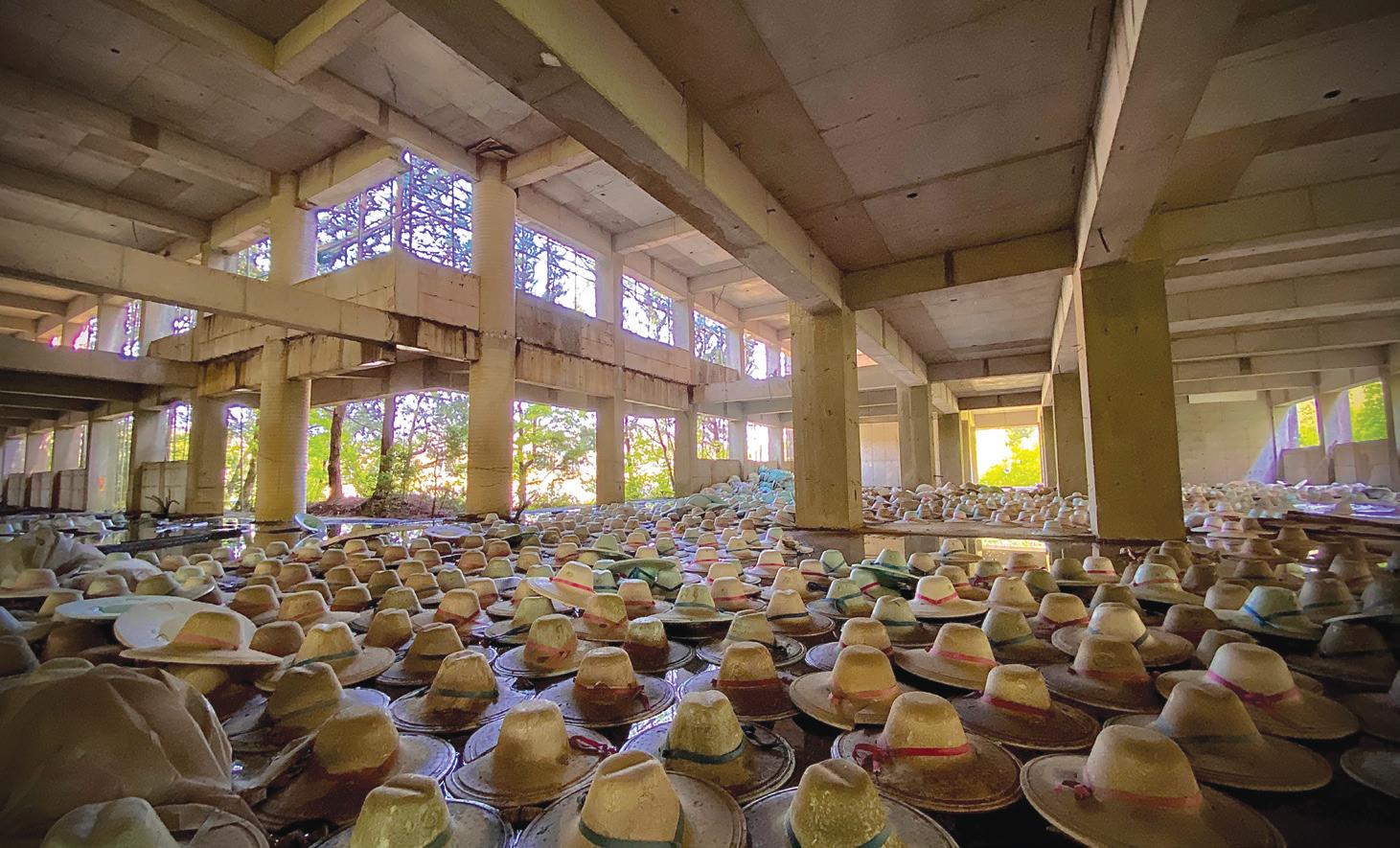
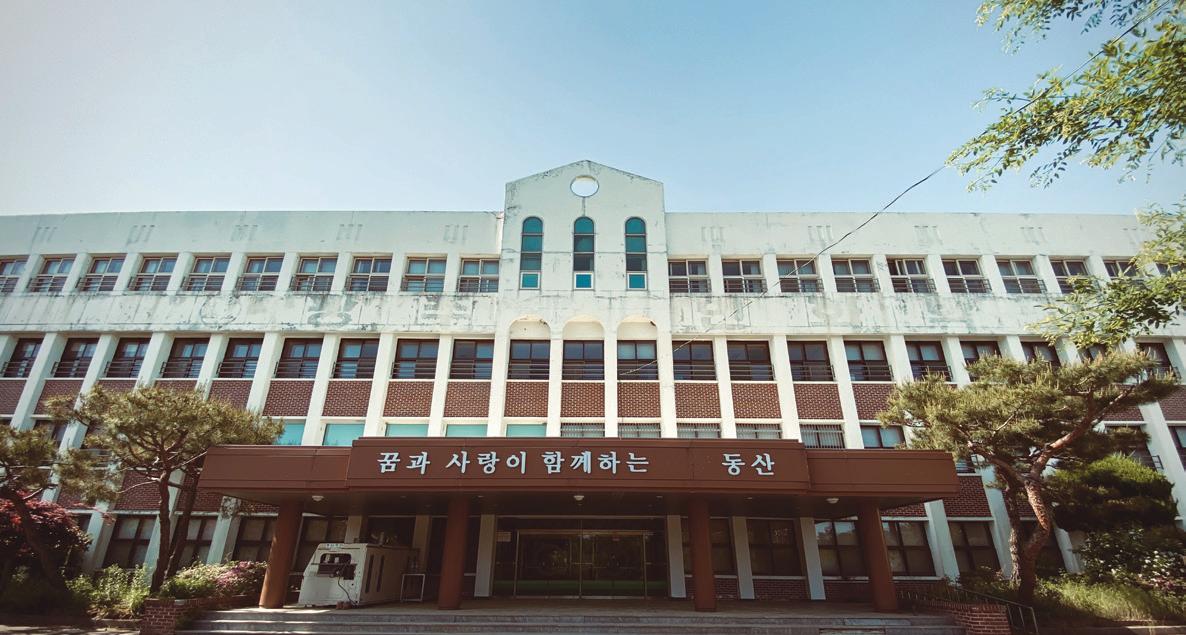
complex featured in this article, Seojin Hospital in Juwoldong still casts its vacant shadow over two nearby girls’ high schools (issue #200), the old Red Cross Hospital downtown still holds 5.18 history hostage (issue #203), and Namgwang Hospital in Mareuk-dong was only recently cleared of its hundreds of poorly secured vials and jars containing diseased organs (issues #210, #211, and #215). There are likely more derelicts like them – these are just the ones I’m familiar with. Venture outside the city and you’ll find entire university campuses that sit vacant as a result of Lee’s education racket.
The nameless concrete shells Lee left out in Samgeo-dong aren’t much to look at, though they’re fun to walk through and still yield a few interesting sights. Most interesting are the hundreds of Styrofoam sunhats someone abandoned inside on the first floor. As the buildings tend to flood when it rains, the hats eerily float across the surface like water striders. To the artsy soul who meticulously set the hats out in this way, thank you. I appreciate the surreal quietude of your work. Aside from its makeshift art installation and connection to Lee, who’s now himself rotting in Gwangju Prison for his many Ponzi schemes, the complex is also intriguing for the far more unsettling complex that sits next door.
The adjacent complex is none other than Gwangju Mental Hospital, which includes the now shuttered Gwangju Inhwa School for hearing-impaired children. The school initially made headlines in 2005 when half a dozen staff members – the principal included – were accused of physically and sexually abusing at least nine students. Following trial, a few of the convicted were sent to jail while others got off free due to the then statute of limitations on sex crimes. Soon after, an appellate court reduced the sentences further, with two of the convicted
▲ Hundreds of sunhats await the rain. Artist unknown.
being released from jail as a result. Among these was the principal who, instead of serving his original five-year sentence for raping a 13-year-old student, got off with probation and a fine of three million won. Remarkably, a few of the accused teachers even returned to work at the same school, while the lone teacher credited with exposing the abuse was fired. [1][2]
Sickening as the case was, it wasn’t until the widely seen film Dogani (2011) came out that the Korean public became incensed by the scandal and pressed for change. Based on the eponymous 2009 novel by Gong Ji-young, the film was inspired by the horrors that took place at Gwangju Inhwa School and detailed the revolting abuse endured by the students, in addition to the efforts of said teacher to reveal their suffering to the public. An instant hit, the film was soon seen by millions of Koreans, including then President Lee Myung Bak who, according to his spokesperson, said, “We need to pay more attention and care for the minorities in society.” [3]
In a twist of irony, members of the then Grand National Party’s Human Rights Committee called for Gong, the author of the roman à clef, to be investigated for exaggerations in both her novel and its film adaptation and because she was “engaging in political activities.” Gong got the best of the exchange via Twitter by agreeing and amplifying: “Now the GNP has begun its plan to make me into a world-renowned author. Much appreciated.” [4] Rather than launch any investigation into Gong, what actually resulted from the public uproar was a rapid police investigation of the school to find further irregularities. [5]
In fact, only two months after the film’s release, Gwangju Inhwa School’s licensing as a social welfare school was
revoked, and the students were set to be relocated. In addition, the local education offi ce either suspended the jobs or canceled the teaching licenses of teachers involved in the scandal. [6] Also within that timeframe, the National Assembly passed the “Dogani Law,” a revision of the sexual crimes bill that removed the statute of limitations and allowed for heavier penalties in cases of sexual abuse involving children under 13 and the disabled. Additional sentencing was tacked on for any organization staff or administrative heads who were found guilty of such crimes. [7]
Today the Gwangju Inhwa School sits empty, and its late principal lies dead from pancreatic cancer. On my last visit to the area, I noticed an absurdly large statue of Jesus with outstretched arms nestled into the nearby hillside. Wanting a closer look, the “path to Jesus” took me past yet another forested complex in the area – a sort of religious school retreat that I’d never seen before. Staff members there were extremely kind and guided me on the right path to their oversized Messiah. Passing through the complex, I spotted a young girl of maybe 12 or 13 waving joyfully to me from a second-story window. A sinking sadness rushed over me when I realized she was special needs. Masking a smile, I waved back and continued on my path.
▼ Th e stillborn architecture of Hongbok Academy. [1] Kim R. (2011, September 27). Film ignites call for probe into assaults. Th e Korea Times. http://www.koreatimes.co.kr/www/news/ nation/2011/09/117_95595.html [2] Bae J. (2011, September 29). Film rekindles rage over Inhwa School case. Th e Korea Herald. http://nwww.koreaherald.com/view. php?ud=20110929000867 [3] Kim R. (2011, October 04). “Dogani” school faces closure.
Th e Korea Times. http://www.koreatimes.co.kr/www/news/ biz/2011/10/113_96054.html [4] Jung, D. (2011, October 29). GNP calls for investigation into “Th e
Crucible” author. Hankyoreh. http://english.hani.co.kr/arti/english_ edition/e_national/503050.html [5] Chosunilbo. (2011, September 29). Police to reinvestigate sex-abuse claim at deaf school. http://english.chosun.com/site/data/html_ dir/2011/09/29/2011092901215.html [6] Na, J. (2011, October 31). “Dogani” school to be shut down.
Th e Korea Times. http://www.koreatimes.co.kr/www/news/ nation/2011/10/113_97714.html [7] Kim, R. (2011, October 28). National Assembly passes “Dogani
Law.” Th e Korea Times. https://www.koreatimes.co.kr/www/ nation/2020/02/113_97529.html
The Author
Originally from Southern California, Isaiah Winters is a Gwangju-based urban explorer who enjoys writing about the City of Light’s lesser-known quarters. When he’s not roaming the streets and writing about his experiences, he’s usually working or fulfi lling his duties as the Gwangju News’ heavily caff einated chief proofreader.
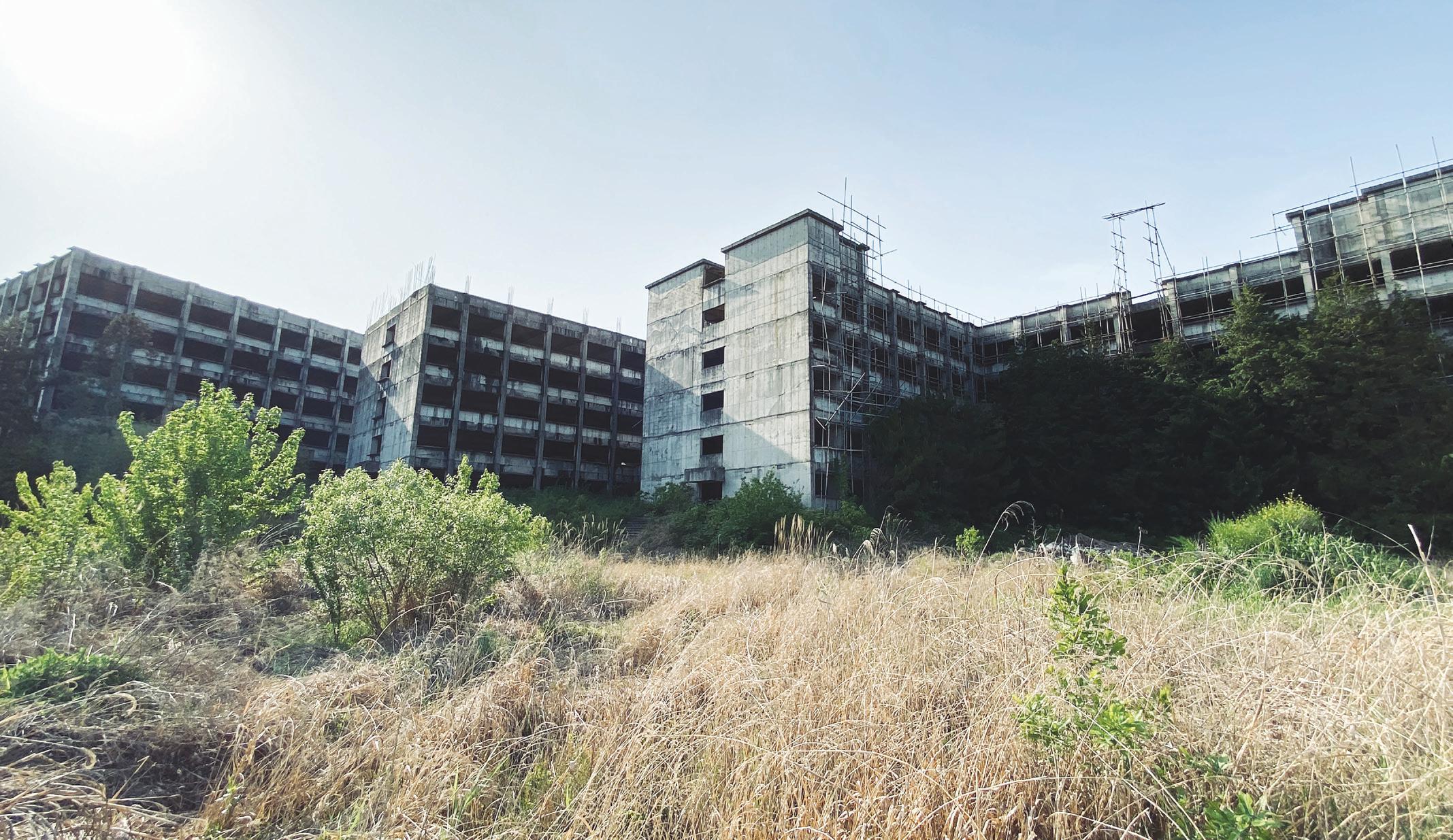
Belarus and Belarusians 10 Little-Known Facts
Written by Viktoryia Shylkouskaya
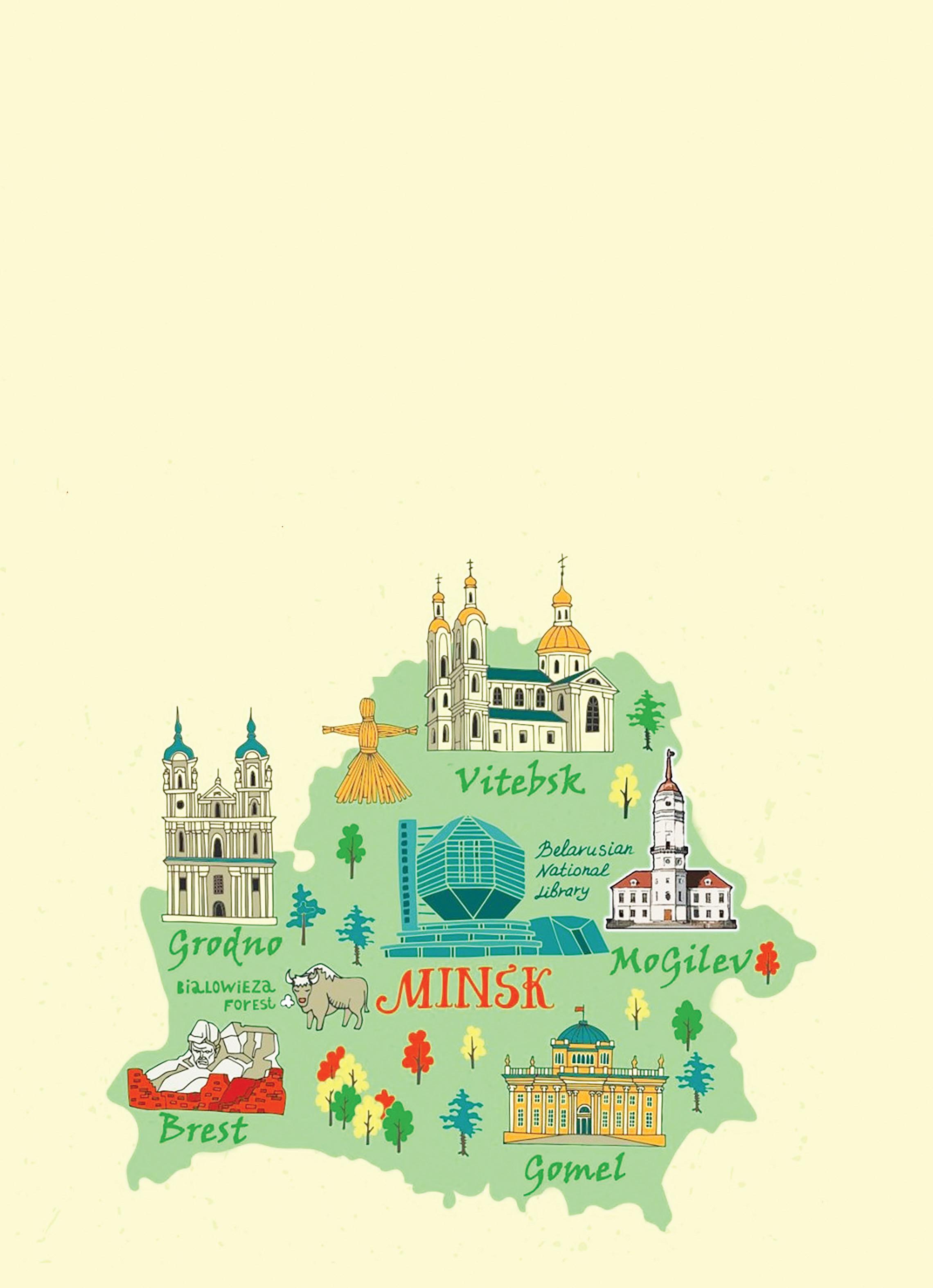
Belarus is a beautiful country located in the very heart of Europe. But not many people know that Belarus, a country of 10 million people, even exists! That is exactly what this article is on a mission to fix.
Belarus, located on the eastern edge of Eastern Europe, is often called the last dictatorship on the continent and, for some, is still considered to be part of Russia. Officially, the name of the country is the Republic of Belarus (Belarus, for short), but it got its name only in 1991, just 30 years ago. Before then, Belarusian lands were called the Principality of Polotsk, the Principality of Turov, Kievan Rus, the Grand Duchy of Lithuania (13th–16th centuries), the Polish-Lithuanian Commonwealth (16th–18th centuries), Northwestern Krai of the Russian Empire, and others. Historical materials show that for more than a thousand years, Belarus was a part of other state formations, but it is also important to note that it has never been a colonial territory. Being always in a mix with other territories and nations played an integral part in the Belarusian ethnos-forming process.
‘‘There is no easy way from the earth to the stars,”Seneca said, and he was absolutely right. You can become a truly successful person only with the help of hard work. Many people who changed the world were originally from Belarusian lands.
Marc Chagall
Many of you have probably seen the famous Marc Chagall’s painting “Above the Town.” But did you know that Marc Chagall is from Belarus? One of the most famous people from Belarus, particularly in the city of Vitebsk, Chagall was a talented painter, graphic artist, and vivid representative of the 20th-century avant-garde who fascinated the world with his unique style. While many in Russia claim him as one of theirs, Marc Chagall’s house and museum is open to visitors in Vitebsk, Belarus, and his famous paintings – “To My Betrothed,”
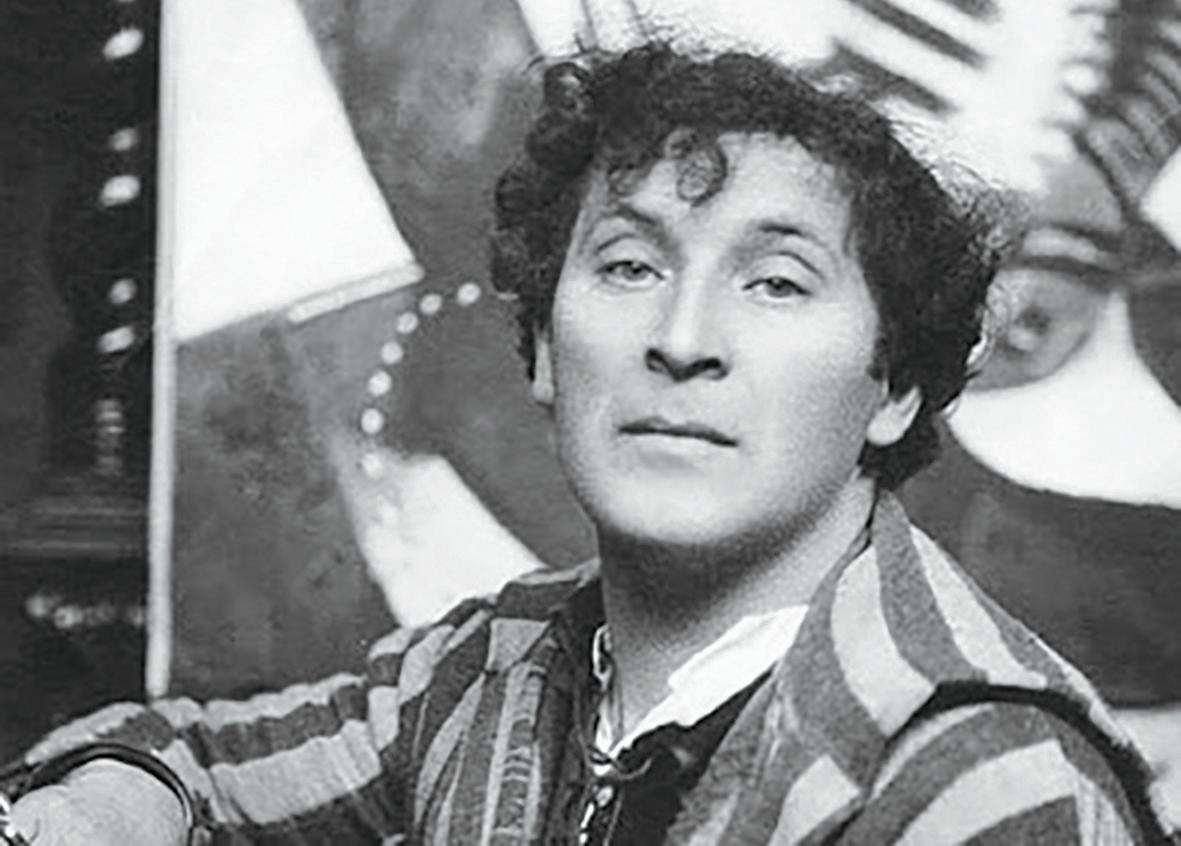
▲ Painting “Over the Town,” 1913 by Marc Chagall. (Marcchagall.net)

“I and the Village,” and others – are exhibited in galleries around the world.
Tadeusz Kosciuszko
My list of famous Belarusians continues with Tadeusz Kościuszko, a military engineer and hero in Belarus, Poland, Lithuania, and even the United States of America. He was born in what is today Kosava, a town in the western part of Belarus. He was the leader of the national liberation uprising in 1794 in the PolishLithuanian Commonwealth and took part in the American Revolutionary War. Nowadays, there are over 200 monuments around the world dedicated to Kosciuszko, and people in Belarus bring Kosciuszko’s portraits to protest against the rule of the current Belarusian president.

Barys Kit
Perhaps you did not know that, among the world’s many scientific discoveries, it was the Belarusian Barys Kit and his rocket propellant formula that made it possible to make the first-ever trip to the moon during the Apollo missions. Barys Kit worked for 25 years in the American space research program. Despite his emigration, Kit stayed a staunch Belarusian throughout his life: “Everything I did in my life, I did for my homeland and its fame.” He lived out his final years in a Jewish nursing home in Germany, and celebrated his last birthday (his 107th) in 2017. ▲ Barys Kit (Intex-press.by)
Svetlana Alexievich
The only Belarusian – so far – to win the Nobel Prize in Literature made the world google where and what “Belarus” was in 2015. Svetlana Alexievich is the first writer from Belarus to receive the coveted award. Born in the western Ukrainian town of Stanislav to a Belarusian father and a Ukrainian mother, Svetlana Alexievich grew up in Belarus. During her career in journalism, Alexievich specialized in crafting narratives based on witness testimonies. In the process, she wrote oral histories of several dramatic events in Soviet history: the Second World War, the Afghan War, the fall of the Soviet Union, and the Chernobyl disaster.
Victoria Azarenka
Belarusian Victoria Azarenka has been one of the best tennis players in the world since 2008, winning the title of “world’s number 1 tennis player” in 2012. She held the Women’s Tennis Association’s (WTA) number 1 ranking until 2013. Overall, Azarenka has won 20 WTA singles titles, eight WTA doubles titles, and three mixeddoubles titles. In August 2013, Azarenka was named the fourth highest-paid female athlete in the world by Forbes
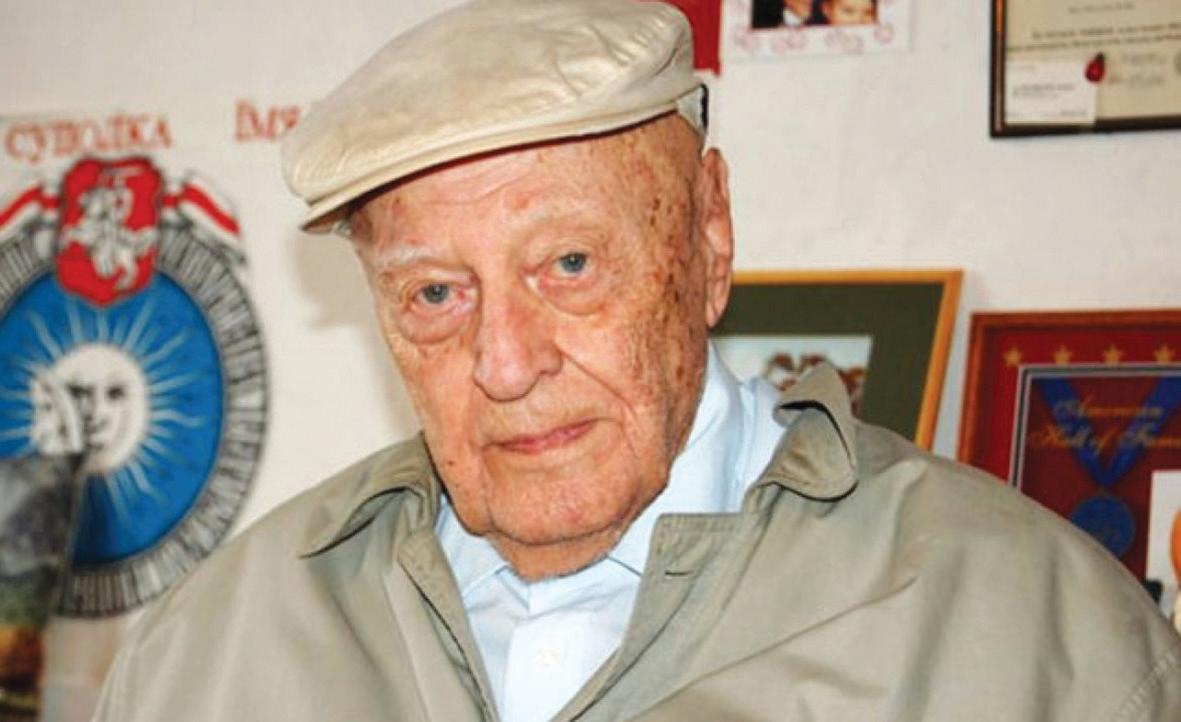
Magazine. Impressive, is it not?
▼ Portrait of Svetlana Alexievich. (Niklas Elmehed © The Nobel Foundation)
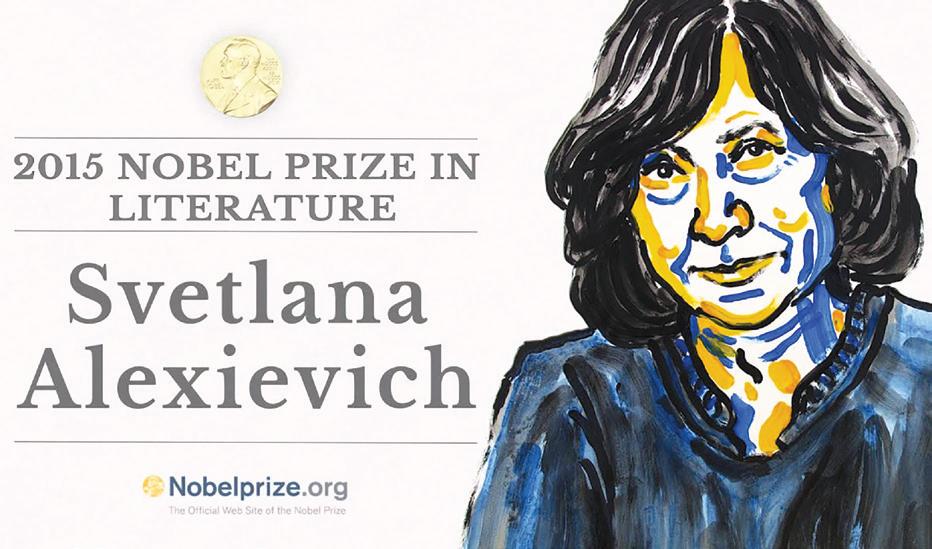
▲ Victoria Azarenka at the Rogers Cup, Montreal, Canada, 2018. (Minas Panagiotakis © Getty Images)

Belarusian IT Guys
In Belarus, every second child, instead of wanting to become an astronaut, wants to become a programmer. Being a programmer in Belarus, as well as in many other countries in the world, means receiving one of the best salaries among many occupations. Have you heard of a computer game called “World of Tanks”? What about “World of Warships” or “World of Warplanes”? All of these games were created in Belarus! The Belarusian national airline Belavia, in showing its support for the local businesses, repainted one of its planes with the colors of the “World of Tanks” game. Many of you might be using the “Viber” app on your smartphones, the third most popular messaging app after Facebook Messenger and WhatsApp. As you can probably
▼ Wargaming Games (Wargaming.com)

guess, this application was also created by Belarusian programmers. In addition, the MSQRD app, which puts an animated mask on your face, was created in Belarus. Aft er having 10 million downloads, it was bought by Facebook in 2016.
Louis Bart Mayer
Immigrants from Belarus have left their mark on the development of world cinema, too. For example, Louis Bart Mayer who came from Minsk, became famous in the fi eld of world cinematography. He is well known not only as a founder of the Hollywood fi lm studio MetroGoldwyn-Mayer but also as one of the promoters of the American Society of Cinematographers. Th e idea of presenting the annual Oscar award also belongs to him.
You will be surprised to learn that many Hollywood celebrities can trace their ancestry back to Belarus. For example, Lisa Kudrow of the sitcom Friends as well as Scarlett Johansson, Harrison Ford, Michael Douglas, and others have origins in Belarus!
Lisa Kudrow
One of the stars of the television sitcom Friends is not as American as she may seem. Actually, Lisa Kudrow’s grandad was born in Mogilev and her grandma in the village Iwye, located in the Hrodna region of Belarus. Her father’s mother immigrated to Brooklyn in 1921, where her father grew up. Some years ago, Lisa visited Minsk, Vileika, and Iwye to reconnect with her Belarusian roots.
Scarlett Johansson
One of the world’s most popular, beautiful, and highestpaid actresses, Scarlett Johansson spoke about her Belarusian origins at a press conference in Moscow in 2012. Back then, she said that her mother was originally from Minsk. Meticulous historians later found that the star’s great-grandfather and great-grandmother actually lived in Nesvizh. Th e superstar promised to visit her historic homeland. Well, what can we say – we are still waiting!
Harrison Ford
Known for his legendary roles in the Indiana Jones and Star Wars fi lm series, Harrison Ford was born in Chicago. Th e actor’s maternal grandparents, however, were from Belarus and emigrated from Minsk to New York at the beginning of the last century. Ford himself spoke about his ancestors on the eve of the premiere of the next Indiana Jones fi lm back in 2008.
Michael Douglas
One of the most famous Hollywood actors also has Belarusian roots. His father, Kirk Douglas, was born
▲ Hollywood celebrities with Belarusian roots. (Pavel Supanenka © Youtube)

into a family of emigres from Chavusy, Mogilev Oblast, which is in eastern Belarus.
Like any other nation, the Belarusians are unique in their own way. Th ey have for centuries celebrated their lands, used a diff erent language, and gone by diff erent names. Many of those who were born here do not consider themselves Belarusians, as the borders shift ed faster than their identities could. All these people were born in a small country (we still need to explain to foreigners where our country is located). But it does not matter: Th e past, present, and future of our country are all built by great people!
▼ “Belarus Is My Country.” (Maksim Piakarski © Symbal.by)

The Author
Viktoryia Shylkouskaya is a 26-year-old Belarusian currently residing in Gwangju. She moved to South Korea in 2016 without any knowledge of the country or language. What she thought would only be one year has since turned into many more. Instagram: @shylk.vick


Ultimate SummerGetaway
Little red poppies can be easily found pretty much anywhere in Jiri-san Cheese Land.
Jiri-san Cheese Land in Gurye
Written and photographed by Cami Ismanova
Gurye is a small green town in Jeollanam-do widely known for its mountainous scenery, in particular Jiri-san National Park, where visitors can see Jirisan (Mt. Jiri), the second tallest mountain in South Korea following its rocky brother Halla-san on Jeju Island. Th ere are three prime peaks: Cheonwang-bong, Banyabong, and the most hallowed peak, Nogo-dan. It is Nogodan that has contributed immensely to the popularity of Gurye as a leisure zone. Th e spectacular view that reveals the beauty of Korean nature can be accessed via hiking to the aforementioned peak. When the southern winds blow, they form a circle of clouds and fog around Nogodan. It is then that the insurmountable Jiri-san stays in its full beauty, ready to steal the hearts of hikers. Hiking the Banya-bong peak is like a well-deserved and anticipated reward for all the eff ort. Visitors can watch both tranquil sunrises and red-fevered sunsets once they climb up to the peak.
Besides being one of the hottest hiking spots in the country, the town of Gurye also off ers a variety of seasonal festivals. Listed below are many, included the Piagol Maple Tree Festival, the Dongpyeon Sori Festival, and the Jiri-san Namak Festival in autumn. In addition, there is the Sansuyu Blossom Festival, the Seomjin River Cherry Blossom Festival, and the Royal Azalea Festival in spring. Th e Sansuyu Blossom Festival is the most popular among locals and tourists for its beautiful yellow blossoms and their medicinal eff ects. Th e positive medical impact of sansuyu (산수유, Japanese cornelian cherry) blossoms was mentioned even in the Dongui Bogam (동의보감), a medical book written by the royal physician Heo Jun during the Joseon Dynasty. Th e book stated that the blossoms, when correctly used, can protect the skin and liver by curing various infl ammations. Locals highly advise drinking sansuyu tea as well as sansuyu liquor if you suff er from high blood pressure or diabetes.
Everything I had heard and seen about Gurye made my trip there inevitable. As a person who loves cheese and religiously consumes it daily, I thought it would be fun to visit trendy Jiri-san Cheese Land (지리산치즈랜드) in Gurye. And guess what? It is totally worth going over there, even for a short picnic. It is no secret that Instagram has become the ultimate travel guru app of our time, with an overabundance of trip tips and stunning visuals. It shows locations, photos, reviews, and sometimes even prices. Enlightened by Insta blogs, armed with KaKaoMap, and driven by a desire to have a break, I was on my way to have an amazing day in Gurye. When I
▲ Jiri-san Cheese Land in Gurye.

fi rst saw Jiri-san Cheese Land’s scenery, it was a perfect composition of colors and tones, almost as if it had been painted by Vincent Van Gogh himself. Nature is indeed the greatest artist of all, for it had created another fl awless masterpiece in Gurye.
Jiri-san Cheese Land is a farming association formed in 1979. In the beginning, they started with only a pair of heifers, but the association has gradually grown into an abundantly successful farming zone that produces a great variety of dairy products annually. It is located pretty close to Jiri-san National Park. A reservoir that appears between the farm and mountains gives a pinch of freshness that plays along the shadows of endless pine trees. Th e cloudy, rainy weather discouraged visitors from visiting Jiri-san Cheese Land the day I was there, but I personally enjoyed my time there by appreciating the combination of peaceful silence and the distant height of Jiri-san. It is just what the doctor ordered for anyone who seeks solitude and peace away from the buzzing cities. Th ere are designated spots for picnic mats and tents, which are perfect for a family trip or a romantic getaway. Every now and then, the roar of motor boats, awkwardly chased by river surfers, will distract you for a moment. But I assure you, it is the only noise pollution there. Although a well-known leisure spot where people visit regularly, it still off ers so much space and solitude!
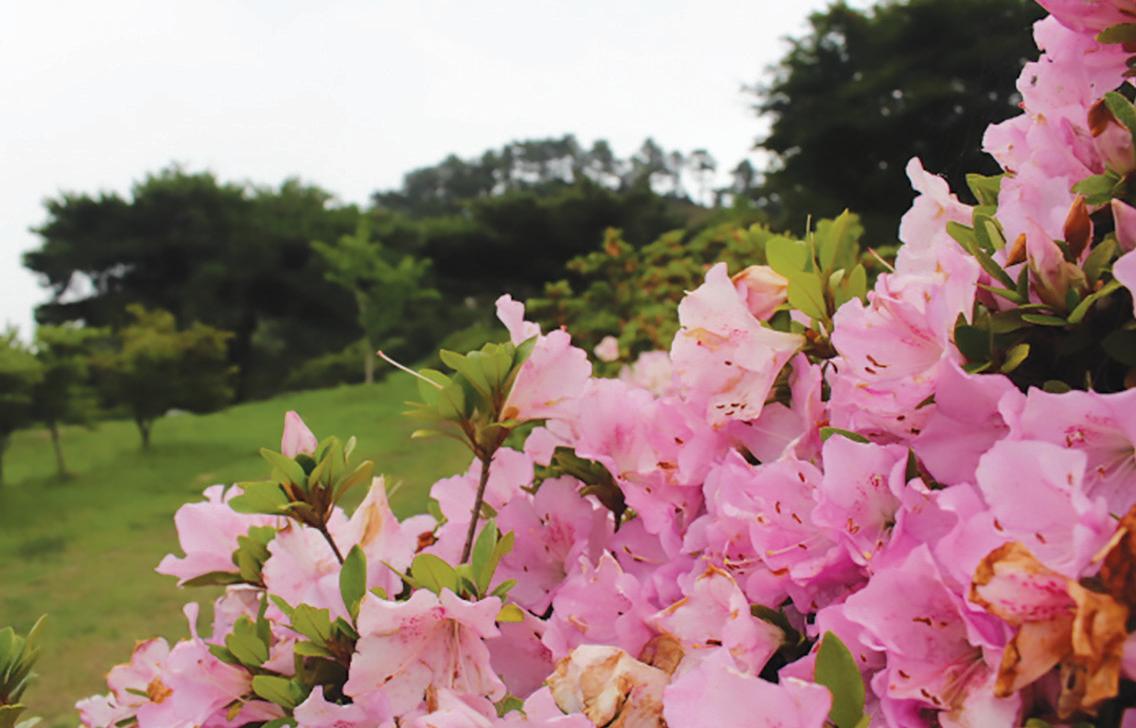
Azaleas are in a full bloom, even in summer.
▲ Clouds and fog embrace the mountains.

How do you get there? It takes around an hour by car from Gwangju. Gurye is a small town, but it is also a tourist-designated area that attracts tourists all year long. Th erefore, buses to and from Gwangju are usually available, and these take around an hour and a half to get there. Th e number of tourists these days is low due to COVID-19’s spread, so I would defi nitely recommend going there on a cloudy, rainy day with a tent. It will save you from the summer heat and crowds. Th ere is a free parking lot and cafe nearby where you can purchase local dairy products. Th e hit of the season are their blueberry and strawberry yogurts! I hope you will enjoy the plethora of natural attractions in Gurye over the upcoming summer weekends.
JIRI-SAN NATIONAL PARK / 지리산국립공원
Address: 133 Ipyeong-ri, Sandong-myeon, Gurye-gun, Jeollanam-do 전라남도 구례군 산동면 이평리 133
JIRI-SAN CHEESE LAND / 지리산치즈랜드
Address: 1590 Saneop-ro, Sandong-myeon, Gurye-gun, Jeollanam-do 전라남도 구례군 산동면 산업로 1590-62, 지리산치즈랜드영농조합법인 Phone: 061-782-2587 Email: taki14@daum.net
The Author
Cami Ismanova is a student at Chonnam National University majoring in economics. In her free time, she enjoys reading books on various topics, traveling around, and writing about the places she has been to. She loves listening to jazz, drawing, and growing fl owers. Cami has been living in Gwangju for three years now. Instagram: @camidisman

Paying Respects to the Dusty Buddhas of Samhong-sa
Written by Ryan Berkebile
Once I discover a neighborhood in the initial stages of a demolition operation, my documenting process begins. The primary motivation for exploring abandoned neighborhoods in Korea is to chronicle the area before demolition workers erase it from people’s memory. Depending on the size of the redevelopment zone, I make numerous visits to the location, using film cameras and an iPhone to shoot scenes that capture my interest. It is quite unbelievable what people leave behind as they vacate their residence or workplace. School annuals, wedding photos, bankbooks, hanbok (한복, traditional Korean clothing), and even graduation certificates are typical examples of personal items that I find while investigating neighborhoods destined for demolition. Abandoned residents, stores, and even shaman’s houses (무당집, mudangjip) are a dime-a-dozen to discover in a jaekaebal jiyeok (재개발 지역) or redevelopment zone. But finding a fully furnished Buddhist temple left unoccupied years ago is unusual. This discovery ranks as one of my most exciting, saddening, and also insightful finds as an urban explorer.
I have found that urban exploration (also known as “urbex”) unveils the absurd situation we call modern living; the scenes shift from the comic (and everything in between) to the profound quickly.
▲ A detail of the water-damaged Sanshin taenghwa.
My experience with this abandoned Buddhist temple would fall somewhere between tragedy and profundity. It does not harm to divulge the temple’s location because it is already gone. Samhong-sa (삼홍사) was a Buddhist temple located on a hill behind the Korea National University of Arts in northern Seoul. Demolition workers, or perhaps scavengers, came and took the paintings (탱화, taenghwa) and Buddha statues of Samhong-sa. On my third visit to the place, my urbex spidey senses tingled as I assessed the temple’s open gate, a sure sign visitors with intentions other than photography had paid a visit. Before that day, the door had been impenetrable. The only way to access the temple was by scaling the wall from the abandoned house next door. Samhong-sa was not a grand, tourist-friendly temple like Jogye-sa (조계사) or Haein-sa (해인사). It was a small house transformed into a place of devotion. The temple provided a refuge for the Buddhists living in the Imun-1-dong neighborhood.
Crossing the threshold, I saw the doors to the Great Buddha Hall (대웅전, daeungjeon) splayed open. Inside I found countertops, dedication cards, and paper lotus lanterns littered on the floor. One lone painting survived the pillage, but debris obscured it from a clear view. It was disappointing on two levels. As a Buddhist, it was difficult to see the beautiful, inspirational images
▲Th e Buddha and bodhisattvas had gone ages without a proper dusting.
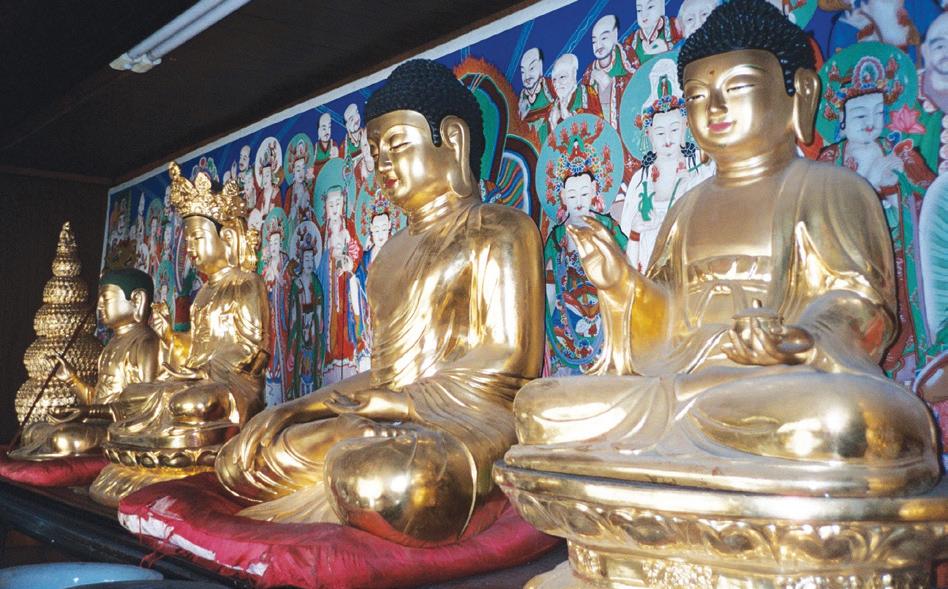
disappear in such a careless manner. Th e second prick of sadness came as an urban explorer. Samhong-sa was a beautiful place weirdly frozen in time. As I mentioned earlier, it is atypical to fi nd abandoned Buddhist temples in Korea, and even rarer to fi nd one left behind with lots of stuff inside. Th is location struck me twice as someone who identifi es with each group. From my experience, Buddhists and urban explorers appreciate and try to express honesty and respect for the impermanence of life. However, each group has its ways and methods of showing it.
Anyone who has spent a signifi cant amount of time at a Buddhist temple in Korea will notice the immaculate interior and exterior of its buildings. Resident monks work tirelessly with laypeople volunteers to maintain a spotless haven for visitors and seung-ga ( 승가, Buddhist monks). Located in a neighborhood that was almost completely clear of residents, I scouted out Samhong-sa a few times before attempting to get in because I could not get a full sense of whether it was empty. One day, I scouted it out from the yard of the abandoned house next door. Th e Great Buddha Hall was intact. It seemed clean and cared for; however, the residential quarters told a diff erent story. Th ere was a gaping hole in the roof where the monks or nuns used to eat and sleep, and it had caved in long ago. Th e wood sticking out was weathered and had been exposed to the elements for quite some time. Yet, despite this visible sign of desertion, I saw old shoes lined up in front of the place, which freaked me out a bit.
Maybe someone was squatting in the Great Buddha Hall, tending the site to protect the Buddhist art and statues? I worked up the nerve to scale the fence and scope out the caved-in building and forgotten shoes before taking a look inside the Great Buddha Hall. I tried to peek through the window of the caved-in building but could not see inside. My imagination ran into overdrive, envisioning the ruined portion of the temple as the fi nal resting place for a monk or nun who died alone and isolated from society. I let go of these thoughts, returning to the present moment and moved on towards the Great Buddha Hall. As I opened the door, there were no signs of a person squatting or caring for the place. It was unfathomable that a tranquil and peaceful place like Samhong-sa would be forgotten and left behind. Th e living quarters appeared trashed, but I held out for hope that a devoted practitioner would periodically come by to look aft er the temple. Aft er my mind settled, it became clear nobody had been here to bow, chant, pray, or meditate for a long time. Dust lingered in the air and coated cushions, tables, and lotus lanterns. Probably the most noticeable grime glazed the golden Buddha and his three accompanying bodhisattvas on the central altar. Th e roof ’s water damage had seeped years of moisture onto a hanging calligraphy scroll and devotional painting for the Sanshin ( 산신, mountain spirit). Despite Samhong-sa’s neglected state, the Great Buddha Hall off ered a tranquil space to those who visited. Underneath the fi lth, its true nature shined. I felt a sense of peace in front of the murky Buddha and bodhisattvas. I imagined they sat waiting serenely for anyone seeking refuge from suff ering, even if only to escape the weather. I received a thoughtful reminder of the precarious nature of life left from the Buddha and his bodhisattvas that day I saw them gone.

The Author
When Ryan Berkebile is not taking pictures of abandoned neighborhoods, he likes to write blog posts for his website, Long Distance Runner. You can see what he has been up to at longdistancerunner.org and on Instagram: @l0ngdistancerunner and @naturaryan1600










